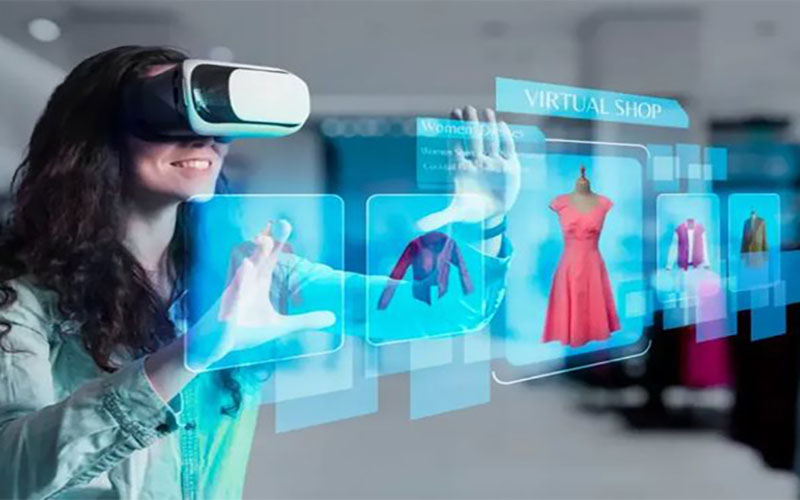
The Evolution of E-Commerce: How Personalization Is Shaping the Future of Online Shopping
Introduction: E-commerce has evolved significantly over the past decade, but one of the most impactful changes in the online shopping landscape is personalization. As consumers become more tech-savvy and demand more tailored experiences, businesses are turning to sophisticated technologies to meet these expectations. Personalization is now a key driver of customer satisfaction, engagement, and ultimately, sales. But what does the future hold for personalized online shopping, and how can businesses harness the power of personalization to stay ahead of the competition? In this blog post, we’ll explore how personalization is shaping the future of e-commerce and offer a few strategies for businesses to implement. 1. The Shift towards Hyper-Personalization: Personalization in e-commerce has moved far beyond simply addressing customers by name in email marketing campaigns. Today’s shoppers expect hyper-personalized experiences that feel tailored to their unique preferences, behaviors, and needs. Thanks to artificial intelligence (AI) and machine learning, businesses can now analyze vast amounts of data to create customized shopping experiences in real time. 2. Personalized Recommendations and AI Algorithms: AI-powered recommendation engines are one of the most powerful tools for e-commerce businesses looking to boost sales through personalization. By analyzing previous purchases, customer profiles, and browsing patterns, these algorithms can suggest products that consumers are more likely to buy, increasing average order value and improving the overall shopping experience. 3. Personalized Marketing Messages: Alongside personalized shopping experiences, personalized marketing messages have become a game-changer for e-commerce brands. Rather than bombarding customers with generic offers, personalized marketing allows brands to send tailored promotions, discounts, and product recommendations based on individual behaviors. 4. Customer Journey Personalization across Channels: Personalization isn’t limited to just one touchpoint or channel. The future of e-commerce personalization lies in delivering a seamless and consistent experience across multiple platforms. Whether a customer is shopping on a desktop, mobile app, or social media platform, businesses must ensure that the personalization experience remains consistent. 5. The Role of Customer Data in Personalization: At the heart of effective personalization lies customer data. Collecting and analyzing customer data allows businesses to understand their customers’ preferences, behaviors, and needs more accurately. From purchase history to demographics and browsing habits, businesses can leverage this information to create a more tailored shopping experience. Conclusion: The future of e-commerce is undeniably linked to personalization. As consumers continue to demand more individualized experiences, businesses must adapt by embracing technologies like AI, machine learning, and data analytics to offer more relevant and tailored shopping experiences. Hyper-personalization, AI-powered recommendations, personalized marketing messages, omnichannel experiences, and responsible data collection will all play critical roles in shaping the next generation of e-commerce.
Read More
The Impact of Voice Search on E-Commerce: How to Optimize for the Future of Shopping
Introduction: As voice-activated assistants like Siri, Alexa, and Google Assistant become increasingly popular, the way we search for products and services online is changing. Voice search is no longer a futuristic concept but an everyday tool for millions of consumers. As voice search grows in use, it’s reshaping how businesses and brands need to think about their digital presence, especially in e-commerce. How do these changes impact the shopping experience? And what can e-commerce businesses do to optimize their websites and online stores for voice search? In this article, we’ll explore the impact of voice search on e-commerce and offer strategies for staying ahead of this growing trend. 1. The Rise of Conversational Search: Voice search has introduced a new form of interaction with technology – conversational search. Unlike traditional text-based queries, voice search often involves more natural, casual language. 2. Local Search and ‘Near Me’ Searches: Voice search is often used on the go, which means many queries are location-based. Consumers frequently ask, “Where can I find a store near me?” or “What are the best restaurants around me?” For e-commerce businesses, this means that optimizing for local search is essential, even if you’re an online-only brand. By ensuring that your business’s name, address, and phone number (NAP) are consistent across various platforms and directories, you can improve your chances of appearing in “near me” voice searches. 3. Mobile Optimization for Voice Search: Mobile devices are the primary platform for voice search, which means mobile optimization is now more important than ever. According to recent studies, over 50% of voice searches come from mobile devices. A mobile-optimized website is crucial for ensuring that consumers who use voice search can easily browse, navigate, and make purchases on your site. 4. Featured Snippets and Position Zero: When it comes to voice search, featured snippets (the “position zero” result on Google) are particularly important. Since voice assistants typically read out the featured snippet as the answer to a question, optimizing your content to appear in this prime position can significantly increase your chances of being chosen by voice search algorithms. 5. The Importance of SEO for Voice Search: While traditional SEO practices still apply, optimizing for voice search requires a different approach. Voice search queries are typically longer and more specific than text-based ones, so focusing on natural language processing and long-tail keywords is critical. Additionally, conversational content that directly answers questions is favored by voice search engines. Conclusion: Voice search is revolutionizing the way consumers shop online, and it’s essential for e-commerce businesses to adapt to this shift. From embracing conversational search patterns to optimizing for local search and featured snippets, companies need to rethink their digital strategies to stay relevant in the era of voice search.
Read More
AI-Powered Product Recommendations: How Smart Algorithms Are Personalizing Online Shopping
The world of e-commerce is evolving at an unprecedented pace, and at the heart of this transformation is artificial intelligence. AI-powered product recommendations are one of the most disruptive innovations in online retail, a game-changer that enhances the shopping experience, increases customer satisfaction, and boosts sales. But how are smart algorithms shaping the way we shop online? The Science behind AI-Powered Product Recommendations Traditionally, product recommendations were based on simple rules like best sellers or user ratings. Today, AI has taken this to the next level by leveraging machine learning, deep learning, and big data analytics to create highly personalized shopping experiences. Here’s how AI-powered recommendations work: Behavioral analytics – AI tracks user behavior, analyzing past searches, clicks, purchases, and time spent on specific products to predict what a customer might like. Collaborative filtering – This technology compares user preferences with those of similar shoppers to suggest relevant products. If multiple users with similar interests have purchased a particular item, the AI recommends it to others with matching patterns. Content-based filtering – AI examines product descriptions, categories, and specifications to suggest items that match a shopper’s previous interests. Real-time data processing – AI continuously updates recommendations based on real-time interactions, dynamically adjusting suggestions as users browse an online store. The impact of AI-driven recommendations on e-commerce AI-powered recommendations aren’t just a feature – they’re a powerful tool that drives customer engagement and increases revenue. Here’s why they’re important: 1. Higher conversions and sales personalized product recommendations dramatically boost conversions by making it easier for users to find the items they’re most likely to buy. Studies show that AI-driven recommendations can increase revenue by 10-30%. 2. Improved customer experience by providing relevant suggestions, AI reduces decision-making stress, making shopping fun and easy. Customers no longer need to scroll endlessly to find what they need. 3. Increase customer retention AI-powered recommendations create personalized shopping experiences, encouraging customers to come back. Retail giants like Amazon and Netflix thrive on personalized recommendations, keeping users engaged for longer. 4. Reduce cart abandonment By suggesting complementary products at checkout, AI can nudge users to complete their purchase, reducing abandoned carts and increasing average order value. The future of AI in personal shopping The next wave of AI-powered personalization will include: Augmented reality (AR) and virtual try-ons – Shoppers can visualize products before they buy, creating a more immersive experience. Voice commerce integration – AI-powered recommendations through smart assistants like Alexa and Google Assistant will make shopping easier. Emotion recognition AI – Advanced AI will analyze facial expressions and emotions to recommend products that match a user’s mood. AI-powered product recommendations are redefining online shopping, creating seamless, engaging, and highly personalized experiences. Businesses that leverage AI-powered personalization will see higher customer satisfaction, improved conversions, and increased brand loyalty. At the University of Cape Town, we specialize in cutting-edge AI solutions that enhance e-commerce experiences. Want to transform your online store with intelligent recommendations? Let’s build the future of AI-powered shopping together!
Read More
How AI-Powered Search Is Changing the Way Consumers Shop Online
In the fast-paced world of e-commerce, search is no longer just typing keywords into a search bar and scrolling through endless results. Thanks to AI, online shopping has become smarter, more intuitive, and more deeply personalized. AI-powered search is revolutionizing the way consumers find products, making the experience faster, more efficient, and more relevant to individual needs. The evolution of online search: Traditional keyword-based search engines often produce frustrating results—misspelled words, vague queries, or too many irrelevant results. AI-powered search removes these anomalies by understanding intent, context, and user behavior in real time. Through technologies like machine learning (ML), natural language processing (NLP), and computer vision, AI makes online shopping a more seamless experience. How does AI-powered search work? AI-powered search engines use advanced algorithms to predict, interpret, and optimize search results. These technologies analyze massive amounts of data, learning from user behavior to deliver highly personalized shopping experiences. 1. Natural Language Processing (NLP) AI understands conversational language, allowing users to search in a more natural and human way. Instead of typing in strict keywords, customers can ask questions like, “What is the best budget-friendly smartphone with a great camera?” and get highly relevant results. 2. Visual Search Shoppers can now upload a photo instead of typing in a query. AI analyzes the image, identifies key features, and presents matching or similar products. Platforms like Pinterest and Google Lens have already integrated visual search, allowing consumers to shop using just a photo. 3. Voice Search and Smart Assistants With the advent of voice assistants like Siri, Alexa, and Google Assistant, consumers are increasingly using voice search to shop online. AI enables these assistants to process natural speech patterns, making hands-free shopping easier. 4. Personalized Search Results AI-powered search engines track past searches, purchase history, and browsing behavior to predict what a user is searching for before they type it in. This personalization increases conversion rates and enhances the overall shopping experience. The impact of AI-powered search on ecommerce: 1. Faster and more accurate product discovery AI-powered search filters millions of products in milliseconds, ensuring consumers find exactly what they need without endless scrolling. 2. Higher conversion rates when shoppers get relevant results quickly, they are more likely to complete a purchase. AI-powered search increases the chances of converting searches into sales. 3. Better customer retention a seamless shopping experience keeps customers coming back to you. AI-powered search ensures that they always find what they need effortlessly, which fosters long-term brand loyalty. 4. Lower cart abandonment when users can quickly find what they’re looking for — without frustration — they’re less likely to abandon their shopping carts. Real-world examples of AI-powered search in action: Amazon’s AI search engine – uses predictive analytics and NLP to surface products based on user preferences, search history, and popular trends. Google Lens & Pinterest Visual Search – allows shoppers to search for products using images, transforming the way they discover fashion, home decor, and tech gadgets. Sephora’s virtual assistant – uses AI to analyze customer queries and suggest beauty products based on skin tone, preferences, and previous purchases. What’s next for AI-powered search? The future of AI-powered search will include: Augmented reality (AR) integration – allowing users to visualize products in their space before purchasing. Smarter predictive search – AI will improve search intent with highly personalized recommendations. Cross-linguistic and cross-cultural AI search – breaking down language barriers in global e-commerce.
Read More
How Augmented Reality Will Transform Online Shopping in 2025?
The e-commerce landscape is evolving faster than ever, and augmented reality is at the forefront of this transformation. In 2025, online shopping will no longer be about browsing static images or reading product descriptions. AR is bridging the gap between digital and physical retail, allowing customers to interact with products in a highly immersive and engaging way. The result? Higher conversion rates, fewer returns, and unparalleled customer satisfaction. The Rise of AR in E-Commerce: Augmented reality has gone beyond being a novelty — it’s now an important tool for brands looking to improve customer experience and boost sales. With advances in artificial intelligence, 5G connectivity, and AR technology, businesses can now offer hyper-realistic product previews that make online shopping feel more like an in-store experience. Key Ways AR Is Revolutionizing Online Shopping: Virtual Fashion and Beauty Try-Ons AR-powered virtual try-ons allow customers to see what clothes, accessories, and even makeup would look like on them — without stepping foot in the store. Brands like Sephora and Gucci are already using AR to track faces to help customers try on different shades of lipstick or glasses before making a purchase. AR for Home Shopping and Furniture Giant retailers like IKEA and Wayfair have integrated AR-powered apps that allow users to visualize furniture and decor in their homes. By overlaying life-size 3D models, shoppers can make more informed purchasing decisions, reducing the hassle of returns. Interactive 3D Product Previews Static images are becoming obsolete. With AR, customers can rotate, zoom in, and inspect products in 3D before purchasing. This feature is especially useful for gadgets, appliances, and high-end consumer products. AR Showrooms Some brands are taking AR to the next level by creating fully immersive virtual showrooms. Instead of visiting a physical store, customers can walk through a 360-degree AR shopping experience, interacting with products as if they were right in front of them. Business Benefits of AR in Online Shopping: Increased Conversion Rates Customers are more likely to complete a purchase when they can see and interact with the product before they buy. Studies show that AR-powered product visualization leads to a 40% increase in conversion rates compared to traditional e-commerce. Lower Return Rates High return rates are one of the biggest pain points for e-commerce businesses. AR helps eliminate uncertainty by giving customers a realistic preview, leading to more confident purchasing decisions. Enhancing Customer Engagement AR experiences keep users on websites and mobile apps for up to three times longer, increasing brand engagement and boosting customer loyalty. Competitive Advantage Brands that embrace AR are ahead of the curve, offering unique shopping experiences that set them apart from competitors who still rely on traditional methods. What’s Next for AR in Online Shopping? AI-Powered Personalized AR Experiences – Future AR systems will use AI to recommend products tailored to individual preferences, making shopping easier and more efficient. Web-based AR (no app required) – Instead of downloading separate apps, customers will be able to experience AR directly from their web browsers. Haptic feedback and AR shopping – The future may bring technology that allows users to “feel” textures and materials through AR-enhanced shopping. Augmented reality is no longer just a futuristic concept, it is a game-changer that will redefine online shopping. In 2025, AR will enhance product discovery, personalize shopping experiences, and increase sales while reducing returns. Companies that invest in AR-enabled e-commerce solutions will not only improve customer satisfaction, but also secure a competitive advantage in an increasingly digital world.
Read More
MiaBanko
In the evolution of MiaBanko, UCT played a pivotal role in enhancing various aspects, starting with a comprehensive revamp of the authentication process. Leveraging Firebase, UCT ensured a secure and streamlined sign-up and login experience, fortified by the implementation of two-factor authentication for added security layers.
Read More
Matjary
UCT meticulously designed and implemented features for Matjary and Matjary Seller/Delivery. The focus was on creating intuitive interfaces, robust security through Firebase authentication, efficient tracking systems, and seamless communication channels. The result was two apps that not only met the challenge but exceeded expectations, providing users and service providers with transformative and streamlined experiences.
Read More
UCT Shop
In the narrative of UCT Shop’s evolution, UCT implemented transformative solutions that elevated the shopping experience for users. The signing process underwent a notable upgrade, becoming secure and hassle-free, ensuring a seamless onboarding for all UCT Shop users. The categorization system within UCT Shop was reimagined, resulting in a well-organized structure that enables users to navigate effortlessly through a diverse array of products.
Read More
Falak Tayb
The challenge for UCT was to create a comprehensive e-commerce ecosystem catering to users, delivery services, and restaurant owners. The goal was to develop distinct apps — Falak Tayb, Falak Tayb Delivery, and Falak Tayb Restaurant — each tailored to meet the specific needs of its users while ensuring seamless integration.
Read More
Talabaty
UCT began by conducting in-depth consultations with the owner of Talabaty to gain a thorough understanding of the app’s requirements. This involved understanding the needs of users, vendors, and delivery drivers, and ensuring that each feature was not only present but also optimized for exceptional user experience.
Read More